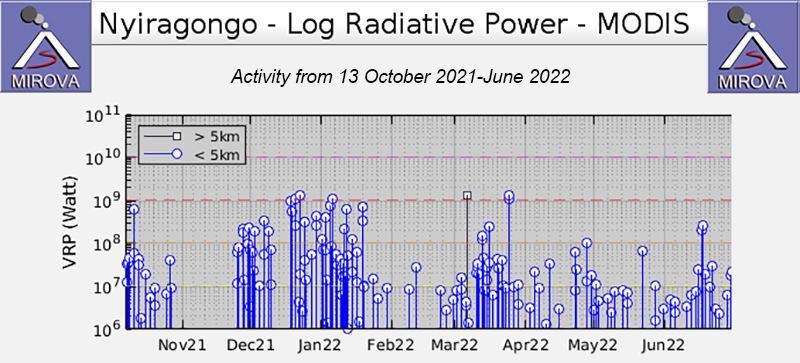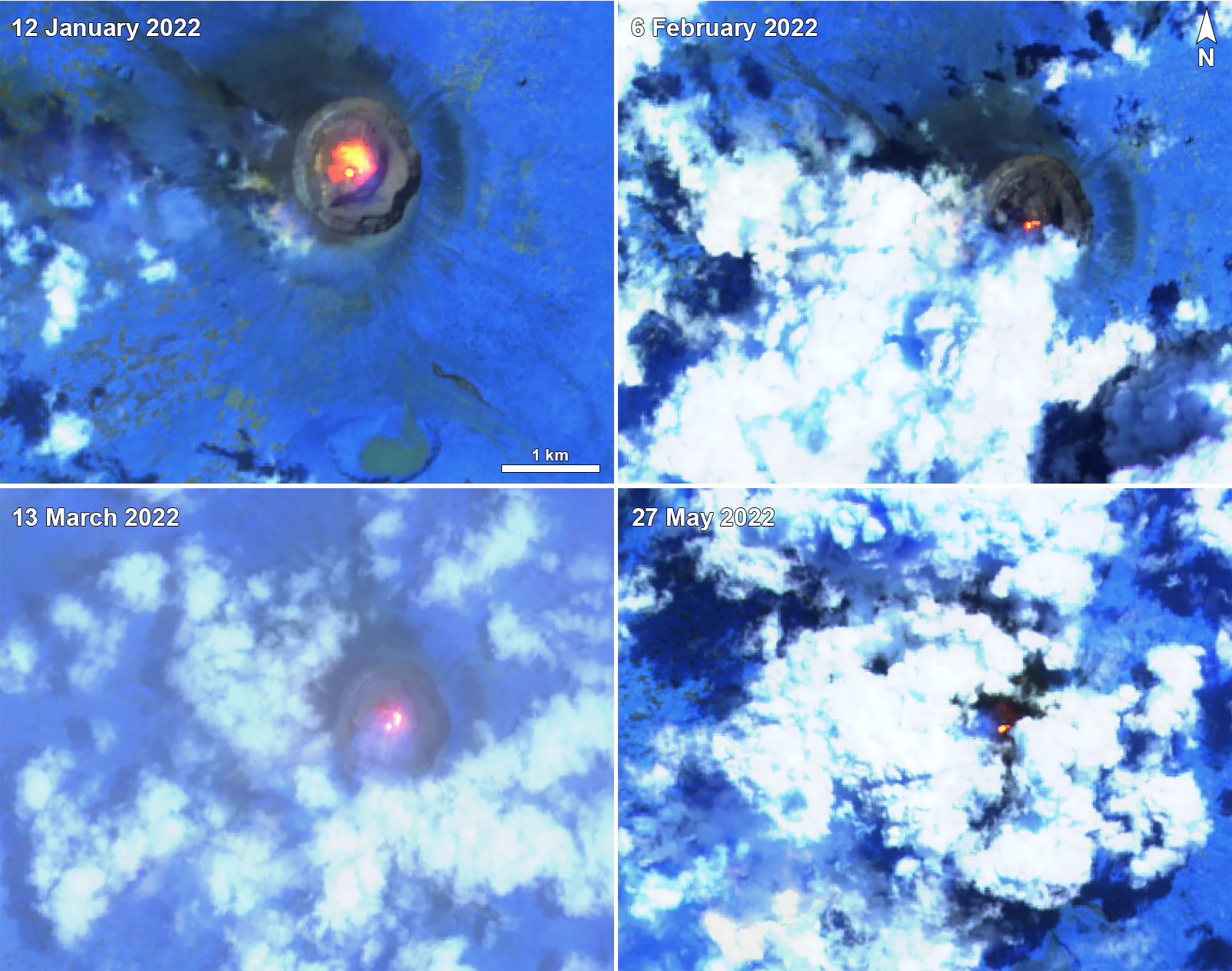Report on Nyiragongo (DR Congo) — July 2022
Bulletin of the Global Volcanism Network, vol. 47, no. 7 (July 2022)
Managing Editor: Edward Venzke.
Edited by Kadie L. Bennis.
Nyiragongo (DR Congo) Strong thermal activity in the summit crater during December 2021 and June 2022
Please cite this report as:
Global Volcanism Program, 2022. Report on Nyiragongo (DR Congo) (Bennis, K.L., and Venzke, E., eds.). Bulletin of the Global Volcanism Network, 47:7. Smithsonian Institution. https://doi.org/10.5479/si.GVP.BGVN202207-223030
Nyiragongo
DR Congo
1.52°S, 29.25°E; summit elev. 3470 m
All times are local (unless otherwise noted)
Nyiragongo, part of the Virunga Volcanic Province (VVP), is located in the Democratic Republic of the Congo along the western branch of the East African Rift system. It contains a 1.2 km-wide summit crater with a lava lake that has been active since at least 1971. Lava flows have been a hazard in the past for the nearby city of Goma (15 km S). During May 2021 a notable flank fissure eruption consisted of intense seismicity, lava lake drainage, lava flows reaching Goma, and ash plumes (BGVN 46:06). The current eruption has been ongoing since 2002 and has recently been characterized by active lava on the crater floor and some spatter, as evidenced by strong thermal anomalies and occasional photos (BGVN 46:12). This report updates information from December 2021 through June 2022 and describes lava effusions along the crater floor during January and March 2022, lava fountaining, and persistent gas-and-steam emissions. The volcano is monitored by the Observatoire Volcanologique de Goma (OVG) and various satellite instruments.
Activity was relatively low during December 2021; according to a news article, notable long-period (LP) earthquakes were detected during 30 November through 5 December and residents of Goma observed crater incandescence on 4 December. OVG reported gas-and-steam plumes and visible incandescence from the crater during 3-5 January 2022. In addition, lava fountaining and collapses at active vents on the crater floor were observed. A growing lava lake was reported, which was also reflected in a 12 January 2022 infrared satellite image of lava effusions covering much of the crater floor. During 13-18 March lava effusion from vents along the crater floor was detected in satellite images. Significant gas-and-steam emissions were visible drifting SW on 13 March.
MIROVA (Middle InfraRed Observation of Volcanic Activity) analysis of MODIS satellite data showed a gradual increase in thermal activity during late November through mid-December 2021 (figure 92). Thermal activity remained relatively high through mid-January 2022 and was followed by a gradual decrease in both power and frequency, which was relatively low during late January through February. Activity gradually increased again in both power and frequency during early March; relatively lower peaks of anomalies were also noted in late April and mid-June. The MODVOLC thermal algorithm detected a total of 97 anomalies in the summit crater, a majority of which were detected during January. Sentinel-2 infrared satellite images intermittently showed a consistent thermal anomaly in the summit crater, with a notably strong anomaly on 12 January and 13 March, representing lava effusions covering much of the crater floor (figure 93). These stronger anomalies were also represented in the MIROVA graph as the stronger peaks during January and March.
Geological Summary. The Nyiragongo stratovolcano contained a lava lake in its deep summit crater that was active for half a century before draining catastrophically through its outer flanks in 1977. The steep slopes contrast to the low profile of its neighboring shield volcano, Nyamuragira. Benches in the steep-walled, 1.2-km-wide summit crater mark levels of former lava lakes, which have been observed since the late-19th century. Two older stratovolcanoes, Baruta and Shaheru, are partially overlapped by Nyiragongo on the north and south. About 100 cones are located primarily along radial fissures south of Shaheru, east of the summit, and along a NE-SW zone extending as far as Lake Kivu. Many cones are buried by voluminous lava flows that extend long distances down the flanks, which is characterized by the eruption of foiditic rocks. The extremely fluid 1977 lava flows caused many fatalities, as did lava flows that inundated portions of the major city of Goma in January 2002.
Information Contacts: Observatoire Volcanologique de Goma (OVG), Departement de Geophysique, Centre de Recherche en Sciences Naturelles, Lwiro, D.S. Bukavu, DR Congo; MIROVA (Middle InfraRed Observation of Volcanic Activity), a collaborative project between the Universities of Turin and Florence (Italy) supported by the Centre for Volcanic Risk of the Italian Civil Protection Department (URL: http://www.mirovaweb.it/); Hawai'i Institute of Geophysics and Planetology (HIGP) - MODVOLC Thermal Alerts System, School of Ocean and Earth Science and Technology (SOEST), Univ. of Hawai'i, 2525 Correa Road, Honolulu, HI 96822, USA (URL: http://modis.higp.hawaii.edu/); Sentinel Hub Playground (URL: https://www.sentinel-hub.com/explore/sentinel-playground); Isabelle Kasoki, Les Volcans News, (URL: https://lesvolcansnews.net/2021/12/07/surveillance-du-nyiragongo-lovg-note-une-baisse-considerable-du-nombre-de-seismes-tectoniques-dans-le-lac-kivu/).



